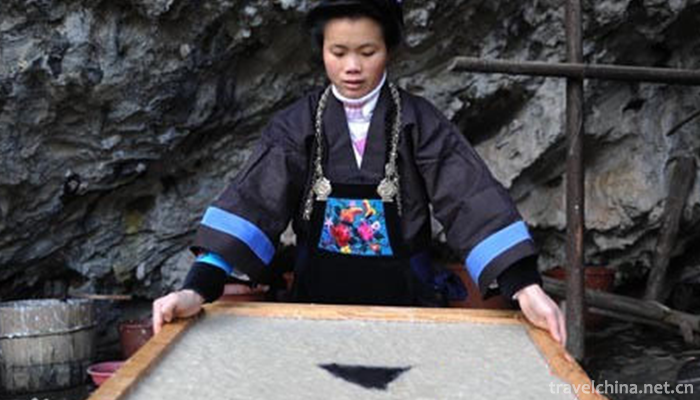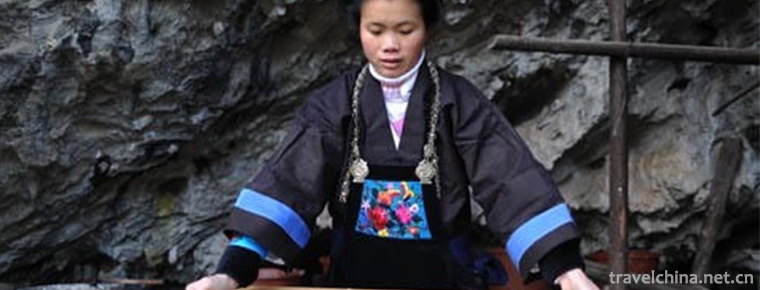Leather Paper Making Skills
Leather Paper Making Skills
Leather paper making technology, Guizhou local traditional handicraft, one of the national intangible cultural heritage.
Leather paper making is an ancient Chinese traditional handicraft. Paper making is one of the four great inventions in ancient China. Bamboo paper and leather paper made from bamboo and tussah bark are two important varieties of traditional handmade paper. Guizhou is a minority inhabited area, and many areas of Guizhou still retain the ancient skills of traditional bamboo paper and leather paper making, among which Xiangzhigou (Buyi nationality), Xiaotun of Zhenfeng County and Shiqiao (Miao nationality) of Danzhai County are the most outstanding ones.
On May 20, 2006, the technology of making leather paper was approved by the State Council and listed in the first batch of national intangible cultural heritage list, the heritage number_-67.
Technological characteristics
Taking bamboo paper produced in Xiangzhigou as an example, it is said that it began in Hongwu period of Ming Dynasty and has a history of more than 600 years. The whole operation process includes 72 processes such as cutting bamboo, breaking bamboo, fencing bamboo, cooking, grinding, pulping, paper making, pressing and drying, which are exactly the same as the paper-making method in Song Yingxing's Tiangong Kaiwu. Its products are both soft and tough, with invisible bamboo patterns and a light fragrance.
The white sponge paper produced in Xiaotun, Zhenfeng County, was originated in Xianfeng period of Qing Dynasty. Up to the end of last century, there were still more than 1000 households engaged in paper making. The paper is made from the skin of the fabric, and the whole set of operation has also undergone 72 processes. The finished product is soft, smooth and soft.
The white paper produced by Shiqiao in Danzhai County is also made of Chinese fir root and bark. In addition, color paper is also produced, including Yunlong fold, concave and convex, flattening, flower and grass, hemp paper. There are more than ten links in the production process. The cotton flocculent pulp is mixed with water and blended with "slipper". The product is packaged by copying, pressing, drying and uncovering. The paper is soft, smooth and water-resistant.
Inheritance Significance
Hand-made paper products have strict requirements on raw materials, water quality and technology. The inheritance of skills depends on oral teaching and heart-to-heart teaching, accompanied by manufacturing, resulting in a rich paper industry custom. Every year, Cai Lun, the master of paper making, is sacrificed. In these cases, the related bamboo paper and leather paper manufacturing techniques have become an important evidence of cultural diversity and national identity. However, under the strong impact of the modern paper industry, the inheritance of these complex and difficult Ancient Papermaking methods has become a problem, which needs to be rescued and protected.
Technological process
There are two processes and more than 30 processes in the production of Longyou Shanya Yanpi paper. One is the production process of leather materials, including chopping, steaming, peeling, steaming, steaming, steaming, spreading, drying, billet making, tearing, cooking, kneading, extrusion, spreading, washing, beating, skinning, washing, drying, bagging and other processes; the other is the production process of finished products, including squeezing, fur troughing, juicing, stirring, paper pressing, baking, paper checking, paper cutting, packaging and so on. Preface. More than 50 kinds of tools with different functions such as Jishan knife, scraper, hydrazone knife, steamer, paper curtain, curtain bed and slot angle are needed in production.
The production process of Longyou Mountain Yanpi Paper depends entirely on the naked eye observation and hand experience of craftsmen. For example, in the paper fishing process, the depth of the curtain bed into the pond and the size of the waves can only be operated by the eye and feel, so as to determine the quality of the finished paper. With the technology of making yam goose skin paper, more than 30 varieties of painting fairy paper, stationery paper, national color paper and special paper can also be processed. They are not only used for painting and calligraphy, but also for binding and packaging.
Inheritance and Protection
Heritage figures
Luo Shouquan, male, Buyi nationality, born in 1942, is from Xiangzhigou, Xinbao Township, Wudang District, Guiyang City, Guizhou Province. In May 2006, the paper making skills were listed in the first batch of national intangible cultural heritage list of traditional skills.
protective measures
National-level inheritors such as Wan Aizhu also guard this ancient handicraft, and actively take protective measures to collect and sort out traditional technological processes, raw material formulations and papermaking equipment, protect the interests of old artists, establish a paper culture museum, and carry out exchange activities of handicraft papermaking skills.


-
1.Donkey HamBurger
Donkey HamBurger is a popular traditional snack in North China. It originated in Baoding. Widely spread in the central Hebei Plain, the brine good donkey meat adds the old soup to join the crispy fire
Time 2018-11-07 -
2.Gold medal suckling pig
Roasted Suckling Pig. Characteristic: It has won the "Golden Ding Award" by the national commercial department. It is a precious Cantonese dish at the banquet.
Time 2018-11-14 -
3.Hailing Island Dajiao Bay Sea Silk Road Tourist Area Yangjiang City
Dajiaowan Scenic Area of Hailing Island in Yangjiang is located in Zhapo Town of Hailing Island, Yangjiang City, Guangdong Province.
Time 2019-01-13 -
4.Little Three Gorges
Wushan Xiaoxiao Three Gorges is the general name of Changtan Gorge, Qinwang Gorge and Sanzhuang Gorge on Madu River, a tributary of Dicuixia of Daning River. Wushan Xiaoxiao Three Gorges is known as t
Time 2019-02-25 -
5.Babao black rice porridge
Babao black rice porridge is a traditional snack and a food for Laba Festival. Purple and black, soft and waxy, sweet and fragrant. Developed from Babao glutinous rice porridge, it has the function of
Time 2019-03-25 -
6.Taoist Drama
Taoist sentiment is a category of traditional Chinese folk art. It originated from Taoist songs such as Chengtian and Jiuzhen in Tang Dynasty. The Southern Song Dynasty began to accompany with fishing
Time 2019-04-25 -
7.Huian womens clothing
Hui'an women refer to a group of special folk women on the coast of Huidong Peninsula, Hui'an County, Quanzhou, Fujian Province. They are famous at home and abroad for their unique clothes and diligen
Time 2019-05-04 -
8.Jiaodong drum
Jiaodong Drum is a folk folk folk art form which originated in the coastal counties of Jiaodong Peninsula. It has a history of more than 260 years so far. It originated from the blind
Time 2019-05-06 -
9.China Youth University of Political Studies
China Youth University for Political Science (China Youth University of Political Studies) is located in Beijing. It is the state-level "Communist Youth League Central Research Center for the the
Time 2019-12-25 -
10.Scientific research on Chengdu Giant Panda Base
As of 2016, it has undertaken one national major basic research project (former "973" project), one national "Tenth Five Year Plan" high technology research (863 plan), several provincial, ministerial and municipal scientific research projects and Chengdu Giant Panda Breeding
Time 2020-12-13 -
11.Guangyuan secondary industry
In 2018, the total industrial added value of Guangyuan was 30.018 billion yuan, an increase of 9.4% over the previous year. The contribution rate of industry to economic growth is 44.3%, which drives economic growth by 3.7 percentage points.
Time 2020-12-15 -
12.Dazhou Sports
By the end of 2019, Dazhou city has a total of 9 stadiums and stadiums, sports lottery revenue of 242 million yuan, and 694 new sports fitness projects for farmers.
Time 2020-12-20